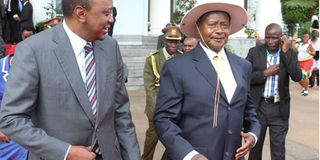It was for a good reason that Kenya lost pipeline deal to Tanzania

President Uhuru Kenyatta with Uganda President Yoweri Museveni (right) at Entebbe State House in Uganda last year. Last week, President Museveni announced that the multibillion-dollar 1,410-kilometre crude export pipeline would run from the western Uganda region of Hoima to the Tanzanian port of Tanga. PHOTO | PSCU
What you need to know:
- The dilly-dallying we saw has nothing to do with Uganda and Kenya. It all has to do with Tanzania and its new president, Dr John Magufuli.
- If the final pipeline decision had been made in 2014, it would have gone through Kenya.
- At that point Jakaya Kikwete was chief in Tanzania. Kikwete represented what, it now seems, could be the last generation of East African “refuseniks” in Tanzania but, particularly, inside the ruling Chama Cha Mapinduzi.
- Though founding father Julius Nyerere was a quintessential East Africanist, his “socialist” Tanzania still often had bitter ideological differences with “capitalist” Kenya.
In recent weeks, it has been intriguing to watch the Uganda oil pipeline dance.
Would it pass through Kenya or Tanzania? Last week, the matter was finally settled. Uganda’s President Yoweri Museveni announced that the multibillion-dollar 1,410-kilometre crude export pipeline would run from the western Uganda region of Hoima to the Tanzanian port of Tanga.
But the way the announcement was made, it was for two pipelines because regional politics demanded that Kenya be seen to also have won.
“I have agreed with President Uhuru Kenyatta to let the two pipelines go ahead," Museveni said at a meeting of East African leaders in Kampala, referring to the pipeline that Kenya plans to build between Lokichar and Lamu.
“If puppies are young, you don’t know which one will be a better hunter, so you feed all of them and when they grow you see which one emerges the best hunter,” he said.
The meaning of that being that if the Tanzania pipeline does not happen in time and the Kenyan one is completed, it can link quickly to Uganda.
MAGUFULI FACTOR
The dilly-dallying we saw has nothing to do with Uganda and Kenya. It all has to do with Tanzania and its new president, Dr John Magufuli.
If the final pipeline decision had been made in 2014, it would have gone through Kenya.
At that point Jakaya Kikwete was chief in Tanzania. Kikwete represented what, it now seems, could be the last generation of East African “refuseniks” in Tanzania but, particularly, inside the ruling Chama Cha Mapinduzi.
Though founding father Julius Nyerere was a quintessential East Africanist, his “socialist” Tanzania still often had bitter ideological differences with “capitalist” Kenya.
It led to that famous spat, with Tanzania describing Kenya as a “man eat man” society, and the Kenyan retort that Tanzania was a “man eat nothing” society.
And there were the sharp differences between Julius Nyerere and Uganda’s abominable military ruler Idi Amin.
It resulted in an invasion by Amin’s troops of Tanzania’s Kagera region in 1978 and the Tanzanian retaliation that, together with Ugandan dissident forces, led to Amin’s ouster in 1979.
The problem is that over the decades, an unwritten assumption developed in East Africa - that Tanzania would always have only one foot in the community and the other out.
Thus, apart from the historical inevitability of returning the EAC headquarters to Arusha, it was assumed that Tanzania would never compete wholeheartedly for other East African goods.
Then along came Magufuli, and he threw everything into winning the pipeline, offering Museveni everything he could to sweeten the deal except giving him Mount Kilimanjaro.
The message in all this is that the rest of the region was too focused on the Tanzanian “refuseniks”, who are understandably emotionally attached to southern Africa, where they had for decades spent a lot of treasure and blood for its liberation, that we did not see the rise of its East African brigades.
SHORTCOMINGS
But it also points to the shortcomings of the methodologies with which regional geopolitics is studied.
Thus in the case of South Sudan, we were led by over-optimism because their struggle for freedom had been so long and bitter. We did not want to think that it would fall apart so quickly. It did.
We have become wedded to the idea that the Democratic Republic of the Congo (DRC) is and will always be a messy big mineral over-rich but backward place, ruled by a corrupt elite in Kinshasa, frightening warlords in the east, crooked international businessmen, and Russian and Western mobsters.
That it will never get its act together. You have to work very hard to find anyone who will paint a picture of prosperity and stability for the DRC in the near term.
It is worse with Somalia because in its case, most of its intellectuals generally paint a bleak picture of it.
At least you will find some Congolese academics who speak to the exciting but hidden things in the DRC that outsiders do not see.
If there are movements in any of these two countries that will bring to power a Paul Kagame, who will put a firm hand on things and stabilise them, or a Magufuli who will end the predatory states that we have in Mogadishu and Kinshasa, we are not seeing them.
They might not be there, but if they are and break out one of these days, we shall again be left asking ourselves: “Where the hell did that come from?”
The author is editor of Mail & Guardian Africa. Twitter@cobbo3




